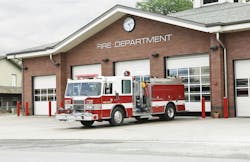Revamping America's first responder infrastructure – an untapped market for contractors
The National Fire Department Registry reveals that America is home to over 52,290 fire stations, managed by approximately 1.2 million career, volunteer, and civilian personnel.
Similarly, state police departments across the U.S. include more than 19,000 local police facilities, 11,788 local police departments, and 2,889 sheriff’s offices, employing over 1 million individuals. This vast infrastructure is crucial to public safety and demands significant investment for modernization and upgrades.
Currently, approximately 43% of fire stations in the U.S. are over 40 years old and in urgent need of renovations. These facilities often lack the latest equipment, technology, and infrastructure to effectively serve their communities.
Police facilities face similar issues. The repair costs for fire departments alone are estimated at about $70 billion annually. This is complemented by an additional $115 billion spent annually on policing, and another $5.4 billion on various capital projects. Notably, there is no consolidated data for capital projects related to police divisions, as funding often comes from multiple sources at the state and local levels.
Given these figures, it is clear that first-responder facilities represent a substantial market opportunity for contractors. Government officials overseeing first-responder operations are continuously seeking assistance, services, products, funding, and collaborative initiatives to address the pressing needs of these facilities.
For instance, in Southampton, Massachusetts, plans are underway to build a new public safety complex that will replace several outdated fire and police stations. The current stations are housed in historical buildings with significant structural issues. The new facility will consolidate the police and fire departments and adhere to all necessary codes and guidelines, including those from the Occupational Safety Administration (OSHA) and the Americans with Disabilities Act (ADA).
The design will feature green technology for efficient heating and cooling, a secure sally port entrance, a training room for police and firefighters, and a community room. Construction is slated to begin within the next two years, presenting a valuable opportunity for contractors specializing in public safety infrastructure.
In Ocean City, New Jersey, a $30 million project is set to renovate and expand the current police headquarters. This initiative includes a $6.5 million project to construct a new police substation. The existing red-brick building, which was originally built as a school in 1980 before being converted into a police station, suffers from a leaky roof and other structural problems.
This renovation is part of a broader $160 million capital improvement plan for the city over the next five years, showcasing a significant investment in public safety infrastructure.
San Mateo County in California is also moving forward with a major project to replace Fire Station 59. The new $20 million station will be relocated approximately 1.7 miles east to avoid the current flood zone. The project is in the design phase, with construction expected to start in 2025. This project presents another substantial opportunity for contractors to engage in vital public safety infrastructure work.
In Newport Beach, California, the city council has approved a $16 million hybrid project to reconstruct and expand both the Balboa Fire Station and the nearby library. The existing library, built in 1929, and the Balboa Fire Station, built in 1962, have not received major renovations in decades.
The new project will include over 9,000 square feet of new construction, green spaces, a playground, and additional public parking. This project highlights the need for modernized facilities that integrate community spaces with critical public safety infrastructure.
Residents of Sycamore, Illinois, are set to benefit from an $11 million project to replace Fire Station No. 1. The existing facility, which suffers from electrical, heating, and drainage failures and contains asbestos, has been inadequate for some time. The new station will feature enhanced space for essential equipment, such as a ladder truck, as well as facilities for training, cooking, and dormitories for on-duty firefighters.
Additionally, the new design will include a public walking path and a multi-use educational area for community safety training. Construction is expected to begin in the spring of 2025, providing another valuable opportunity for contractors to get involved in public safety improvements.
In Johns Creek, Georgia, officials are planning to construct a new fire station that will double the available space and consolidate the city’s south precinct police substation. The $10.4 million project will include structural work, mold remediation, and plumbing upgrades. There is also discussion about adding a third bay at an additional cost of approximately $11.5 million.
The project, which is the top priority in the city’s five-year capital improvement plan, will go out to bid in August. The city aims to consider bids and award construction contracts by September or October 2024.
These examples underscore the extensive and often overlooked needs within the first-responder sector. Upgrading and maintaining these facilities requires substantial investment and presents a significant market for contractors with expertise in public safety infrastructure. The demand for modernized, efficient, and compliant facilities is growing, and contractors who can deliver these solutions are well-positioned to capitalize on this opportunity.
The operations and needs of first-responder units are critical to community safety and deserve focused attention from contractors seeking new collaborative initiatives. By engaging in these projects, contractors can play a vital role in enhancing the capabilities and safety of America's first-responder infrastructure.
About the Author

Mary Scott Nabers
President/CEO of Strategic Partnerships, Inc.
Mary Scott Nabers is President/CEO of Strategic Partnerships, Inc. (SPI), a full-service business development firm specializing in procurement consulting, government affairs, research and public-private partnerships (P3s). A former statewide office holder in Texas, Mary founded Strategic Partnerships, Inc after leaving government and later was the co-founder of the Gemini Global Group.
